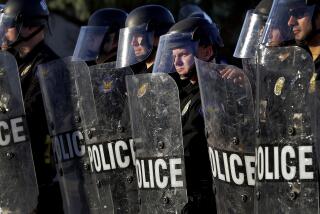Protest, Inquiry in Cincinnati
- Share via
CINCINNATI — A milestone of sorts in the recent racial tribulations of this city was reached Tuesday with little notice: The number of people marching in protest against the police force dropped below the number of federal agents investigating it.
Perhaps 30 people, mostly African Americans, marched to protest as too lenient Monday’s misdemeanor indictments of a police officer in the shooting death of an unarmed black man. Dozens of federal agents, meanwhile, began the kind of in-depth investigations that have led to civil-rights consent decrees in other cities--and considerable resentment in those police departments.
President Bush has expressed doubts about the efficacy of such federal interventions and has suggested that he might halt them, a position that helped him win police-union backing during last year’s election campaign.
Nonetheless, as the protesters marched and chanted beneath sunny skies Tuesday in downtown’s Fountain Square, lawyers from the Justice Department’s civil-rights division began examining whether Cincinnati police exhibit a pattern of excessive force against minorities. The FBI, meanwhile, has begun monitoring the city’s review of the April 7 shooting of Timothy Thomas, 19, which sparked three days of rioting.
Other Justice officials are looking into the actions of police officers who fired nonlethal beanbag weapons at protesters after Thomas’ death. And another group of FBI agents is investigating whether some African American protesters violated the civil rights of white motorists, whom they allegedly dragged from their cars and assaulted during the rioting.
“We have the investigations,” said City Councilwoman Alicia Reece. “Now, we need some true change.”
Officer Stephen Roach, 27, was indicted Monday on charges of negligent homicide and obstructing official business. He shot Thomas once in the chest after a foot chase into a dark alley, later telling investigators that he believed Thomas was reaching for a weapon. He faces nine months in prison if convicted.
Like Monday’s indictments--decried as too lax by many African Americans and too harsh by some police officers--federal civil-rights investigations into police departments have proven controversial, their results unclear.
Since passage of a 1994 crime bill, the Justice Department has had the authority to review local police agencies for patterns and practices of civil-rights abuses. The government has signed consent decrees with police in Los Angeles; Pittsburgh; Steubenville, Ohio; and the New Jersey State Police in hopes of changing tactics and training. It is investigating more than a dozen other cities and counties.
How much the program, championed by former President Clinton’s attorney general, Janet Reno, will thrive in the Bush administration is in question, however, even after this city’s recent miseries.
In a June letter to a Detroit police union, then-candidate Bush said: “I do not believe that the federal government should instruct state and local authorities on how police department operations should be conducted. . . . I will focus my energies on supporting effective law enforcement strategies rather than constantly second-guessing local law enforcement decisions.”
For the first time, the Justice Department is also now running into serious opposition to its decree in Columbus, Ohio. The city has refused to sign a consent decree, has denied charges of racial bias and is fighting the Justice Department in court.
“They came here, they spent a couple weeks, talked to a few complainants, then they went away for about a year,” Bill Capretta, president of the Columbus police union, said of Justice investigators. “Then they came back with a nice letter that says we have determined you have a pattern and practice--those are their words--of racial abuses. That’s what they do. And it’s based on a handful of cases when we have a million citizen contacts a year.”
After a month of protests, resignations by the city manager and chief of public safety, and citywide tension, U.S. Atty. Gen. John Ashcroft’s call for a broader investigation was, at least publicly, welcomed in Cincinnati by everyone from the mayor to the head of the police union. Ashcroft went out of his way to characterize the Justice Department’s role as collaborative with city officials.
Cincinnati police officers have killed 15 black suspects since 1995, four of them since November. No white suspects have been killed during the same period.
Hopeful that the federal investigations will either force change on the 1,000-officer force or help restore faith in it by finding few flaws, city leaders are nonetheless trying to address concerns as swiftly as possible.
On Monday, a few hours before Ashcroft’s announcement--which was timed just before the announcement of the indictments against Roach--a new city ordinance aimed at preventing racial profiling by police went into effect.
On Tuesday, some City Council members asked that a special prosecutor, rather than the city prosecutor, be brought in to handle the Roach case.
City leaders are also talking of raising funds to rehabilitate neighborhoods such as Over-the-Rhine, where much of the looting took place, and of trying to revise the city charter so a police chief can be brought in from outside the department--a move voters have rejected three times in previous years.
They are hoping that, regardless of what all the investigations uncover, this shooting might finally prompt a better understanding between the Cincinnati Police Department--which is 25% black--and the 46% of its constituents who are black.
“It’s pretty quiet today,” one marcher said to another as they headed up Vine Street in the early afternoon. “I actually think that’s good.”
*
Times staff writer Stephanie Simon contributed to this story.
More to Read
Sign up for Essential California
The most important California stories and recommendations in your inbox every morning.
You may occasionally receive promotional content from the Los Angeles Times.










